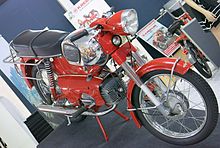
Engine displacement is the measure of the cylinder volume swept by all of the pistons of a piston engine, excluding the combustion chambers. It is commonly used as an expression of an engine's size, and by extension as an indicator of the power an engine might be capable of producing and the amount of fuel it should be expected to consume. For this reason displacement is one of the measures often used in advertising, as well as regulating, motor vehicles.

The Zündapp Janus is a microcar model made by Zündapp in Germany between 1957 and 1958, as the only car ever built by the company.

Zündapp was a major German motorcycle manufacturer founded in 1917 in Nuremberg by Fritz Neumeyer, together with the Friedrich Krupp AG and the machine tool manufacturer Thiel under the name "Zünder- und Apparatebau G.m.b.H." as a producer of detonators. In 1919, as the demand for weapons parts declined after World War I, Neumeyer became the sole proprietor of the company, and two years later he diversified into the construction of motorcycles.
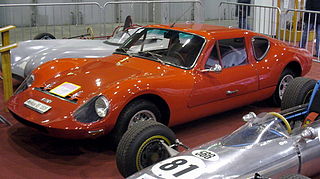
Melkus RS 1000 is a sports car produced by Melkus. It is powered by a tuned, mid-mounted 3-cylinder 2-stroke 992 cm3 engine, similar to the one in the Wartburg 353, and features gull-wing doors. 101 cars were made between 1969 and 1979 in the Dresden factory.

MEBEA was an important Greek vehicle manufacturer, producer of light trucks, passenger automobiles, motorcycles, motorbike engines, agricultural machinery and bicycles.

Kreidler was a German manufacturer of bicycles, mopeds and motorcycles.
Korporacija Fabrika automobila Priboj is a Serbian automotive manufacturer of military vehicles and with the headquarters in Priboj.

Sachs Bikes International Company Limited is a German-based motorcycle manufacturer, founded in 1886 in Schweinfurt as Schweinfurter Präzisions-Kugellagerwerke Fichtel & Sachs, formerly known as Fichtel & Sachs, Mannesmann Sachs and later just Sachs.

The 50 cc class was the ultra-lightweight class in Grand Prix motorcycle racing, and formed part of the Fédération Internationale de Motocyclisme (FIM) World Championships from 1962 until 1983; when the class was replaced by 80 cc.

The BMW R75 is a World War II-era motorcycle and sidecar combination produced by the German company BMW. The BMW R75 stands out by its integral two-wheel drive design, with drive shafts to both its rear wheel and the third side-car wheel, from a locking differential, as well as a transfer case offering both road and off-road gear ratios, through which all forward and reverse gears worked. This made the R75 highly manoeuvrable and capable of negotiating most surfaces. A few other motorcycle manufactures, like FN and Norton, offered optional drive to sidecars.
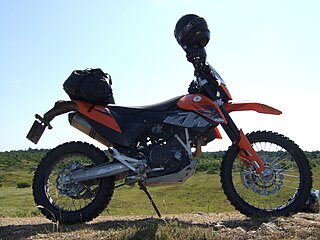
The KTM 690 Enduro is a dual-sport motorcycle made by KTM from 2008 to the present day. The 690 Enduro R, introduced in 2009, was initially marketed as a more offroad-oriented version of the adventure-touring-oriented Enduro. The 690 Enduro nomenclature was dropped in 2011; the 690 Enduro R remains in serial production as of January 2024.

Kreidler is a German band from Düsseldorf, which was founded in 1994. The band combines electronic and analog instruments, and is categorized by critics, depending on the publication, as electronic music, pop, avant-garde, post rock, IDM, ambient, neoclassical, krautrock, or electronica.
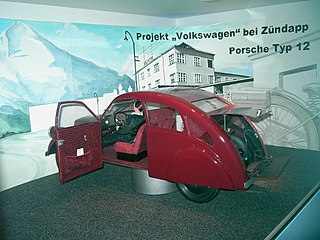
The Porsche Type 12 was a German project to develop an "Everyman's automobile" for Zündapp. Fritz Neumeyer, then owner of Zündapp, ordered Ferdinand Porsche to design and build the prototype in 1931. Eventually, two saloons, and one drophead coupé were built. All of those cars were lost during World War II, the last one in a bombing raid in Stuttgart in 1945. The Type 12 is considered an important early step in the development of the original Volkswagen. A replica of the Type 12 is on static display at the Museum Industrielkultur in Nürnberg.
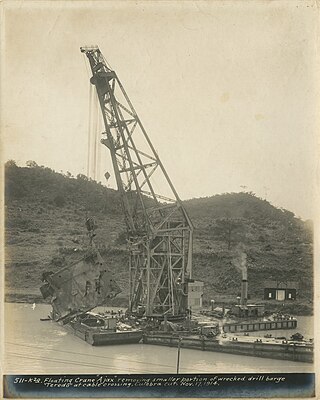
Ajax is a floating crane built to move and install the canal locks and other large parts of the Panama Canal. Ajax also helped in ship repairs and clearing the canal as needed. Ajax and her identical sister crane, the Hercules, were the largest floating cranes at time of completion, able to install the massive Panama Canal locks. Ajax could lift a maximum of 250 tons to a height of 21 feet (6.40 m), with a close reach. At Ajax's far reach she could lift a maximum of 100 tons. Ajax and Hercules were built by Deutsche Maschinenbau AG (1910–1977) . After the Ajax and Hercules, Deutsche Maschinenbau AG later made the Langer Heinrich, or Long Henry in 1915, in use for 100 years.

The Aprilia RSW-2 500 was a racing motorcycle made by Aprilia, which raced in the 500cc class of the Grand Prix motorcycle racing, starting from 1994 until 2000.
Hercules first appeared in Lloyd's Register in 1812, with origin America. In 1813 she appeared in the Register of Shipping with origin Britain. She had undergone a repairs in 1812. She made two voyages as a whaler in the Southern Whale Fishery and then was no longer listed in 1818.
Itom was a motorcycle factory founded in Turin, in 1944, and transferred to Sant'Ambrogio di Torino in 1957/58 where it produced motorcycles until the close of 1975. The owner was the lawyer Corrado Corradi.
